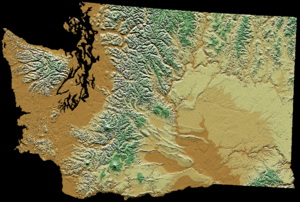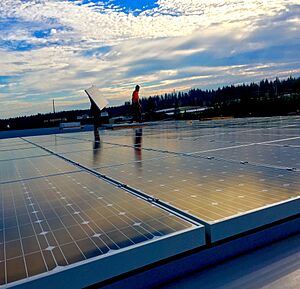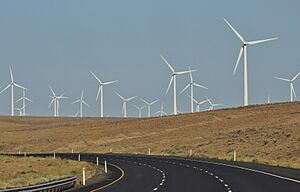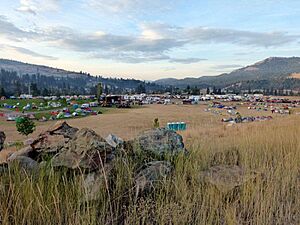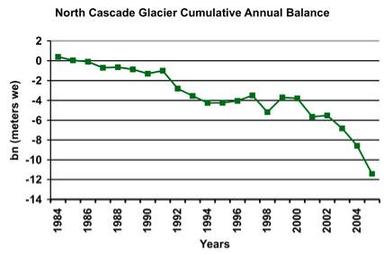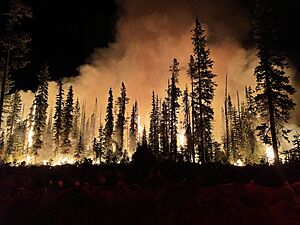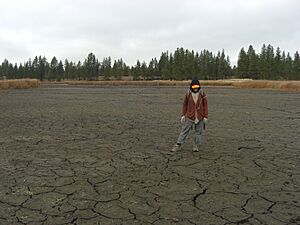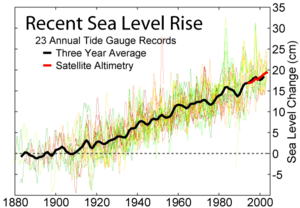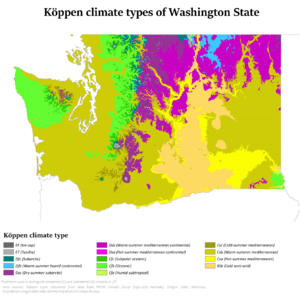Climate change in Washington facts for kids
Climate change in the US state of Washington is a big topic today. It means changes in the weather patterns over a long time. In Washington State, some of the main effects of climate change include more carbon dioxide in the air, warmer temperatures, snow melting earlier in the year, and sea level rise.
You can already see some of these changes. For example, glaciers are shrinking, there's less snow on mountains, spring water runs off earlier, there are more large wildfires, and rising sea levels are affecting the Puget Sound area.
Contents
- What We Expect to Happen
- National Parks
- Electricity
- Municipal Water Supply
- Snow and Ice
- Agriculture
- Fish Industry
- Coastal Management
- Outdoor Recreation
- Sea Level Rise
- Flooding
- Ecological Impacts
- Preparing for Climate Change
- Greenhouse Gas Emissions
- Seattle's Climate Action Plan
- Responses to Climate Change in Washington
- Policy
- CAT's Proposed Reduction of Greenhouse Gases
- Green Building
- Pollution
- No Recyclables in Garbage
What We Expect to Happen
Experts say that Washington State is getting warmer. We expect the temperature to go up by about 0.5 °F (0.28 °C) every ten years. This warming is the main reason for many changes we see. Even if the total amount of rain and snow doesn't change much, warmer temperatures mean more rain and less snow.
Here are some of the main things expected to happen in Washington State:
- More carbon dioxide (CO2) in the air.
- Temperatures going up: maybe 2 °F (1.1 °C) by 2020 and up to 3 °F (1.7 °C) by 2040.
- Snow melting earlier in the year.
- Sea levels rising by about 3 inches to 3 feet (0.91 m) by 2100.
- The total amount of rain and snow each year might not change.
Less snow on the mountains means that rivers will have more water in winter and early spring. But they will have less water in the dry summer months (July to October). These changes can affect how we make electricity, our drinking water, and even fish.
Overall, these changes are causing problems for farming, forests, dairy farms, the wine industry, electricity, and water supplies across the state.
In 2006, scientists and economists looked at how climate change might affect Washington's economy. They found three main things:
- We can already see the effects of climate change, and they are starting to cost money.
- These costs will grow as temperatures and sea levels keep rising.
- Climate change might also create new economic opportunities.
Washington's economy is special because of its natural resources, weather, and industries. Climate change can directly affect how much money we make from these resources. It can also change the quality of important things like fresh drinking water, water for crops, and electricity. It can even affect our health, leading to more sick days or higher healthcare costs. All these things can lower our quality of life.
National Parks
Global warming is a threat to the natural homes of animals and plants in three national parks in Washington State: Olympic, Mount Rainier, and North Cascades. The way water flows through these parks is changing. Glaciers are melting much faster, and we could lose many streams and glaciers in these parks.
In the North Cascades National Park, some streams get about half their summer water from glaciers. Since 1959, the glaciers have lost 80% of their ice. At Mount Rainier National Park, glaciers lost 21% of their size between 1913 and 1994. In Olympic National Park, glaciers like Blue Glacier are also shrinking.
Beyond melting glaciers, the beautiful meadows in Paradise Valley might change. This valley has wide-open spaces and wildflowers because of heavy snow and a short growing season, which keeps trees away. Warmer temperatures could mean trees grow in these meadows, stopping wildflowers. Scientists have already seen meadows shrinking on both sides of the Olympic National Park.
Forests are a big part of Washington's economy. About 22 million acres of Washington's land are forests. These forests support many jobs, from making timber to protecting fresh water and wildlife.
Forest Growth
Climate change could affect how much Washington's forests contribute to the economy. It might change how fast trees grow and which types of trees are most important. It could also affect how much damage pests or fires cause. We don't know if these changes will be good or bad yet.
Tree growth is affected by temperature, soil moisture, and CO2 levels. While we don't have exact numbers for Washington, studies in other places suggest big changes. For example, one study predicted timber yields could drop by 18-31% by the end of the century because of hotter summers.
Pests
Climate change could also change where pests live and how they grow. We don't know much about this yet. Some changes could be good, like old pests moving out of Washington's forests. But it's more likely that new pests will come in. For example, the mountain pine beetle has caused huge damage to forests in British Columbia. This problem is linked to rising temperatures.
Electricity
Washington State gets 72% of its electricity from hydropower, which uses water power. This makes electricity costs very low in Washington. Climate change will affect both how much electricity we have and how much we need.
The biggest factors are temperature changes and when the snowpack melts. If temperatures rise, we might need more air conditioning in summer. This would increase electricity demand. Washington's reliance on hydropower means that changes in snowmelt and river flows are very important for electricity supply.
Snowpack is likely to melt earlier in the future. This means more electricity will be available in early spring when demand is low. But less electricity will be available in summer when demand might be highest. This could seriously affect the state's money. Experts predict that the money made from power sales could drop a lot by 2040.
Because hydropower is more affected by climate change than other energy sources, electricity prices might go up more in Washington than in other states.
Municipal Water Supply
Seattle's municipal water systems might reach their limit by 2050. Experts expect shorter winters and longer summers. This could lead to winter floods and worse summer droughts. A 2005 study found that Seattle could see a 14% drop in water supply by 2040. This is like 170,000 more people moving into the area without enough water.
In 2023, a drought emergency was declared in 12 counties in Washington. This was because the water supply was 75% lower than expected. Climate change likely played a part in this emergency.
Our water comes from glaciers and mountain snowpack. As temperatures rise, snow will fall at higher elevations, and there will be less water during summer runoff. This means less water will be available in the summer. A lack of water will be a problem for both people and wildlife. This is also a concern because the population in the Puget Sound region is expected to grow.
The Seattle area gets most of its water from the Cedar River and Tolt River watersheds. As water levels drop, new water sources will be needed. One idea is to use Lake Tapps. Building new reservoirs or making existing ones bigger will cost a lot of money. It's predicted that by 2040, dangerously low snowpack levels that used to happen every 50 years will happen every 5 years. If there isn't enough water to fill reservoirs, they won't help much. Another option is to make water more expensive for people to encourage less use.
Snow and Ice
Washington State has mountain glaciers in the Olympic Range and Northern Cascades. These glaciers produce a lot of water each year, but they are shrinking fast. The Southern Cascade Glacier in Darington has lost two-thirds of its size. On average, glaciers in these ranges have shrunk by 31 feet (9.4 m) and lost between 18% and 32% of their water volume. If temperatures rise by 3.6 °F (2.0 °C), 65% to 75% of the glaciers could disappear in 40 years.
As glaciers shrink, they reflect less sunlight, causing the surrounding ice to melt even faster. Rivers that get water from glaciers will also be affected. Glaciers provide a steady flow of water after new snow melts. The Middle Fork River, which supplies drinking water to Bellingham, is expected to see big drops in its water levels.
The way precipitation falls in the Cascades is changing. While the total amount of precipitation hasn't decreased since the 1950s, more of it is falling as rain instead of snow. The amount of water flowing into Puget Sound has dropped by 18% since 1949.
Water flows in Washington can be grouped into three types: rain-dominant, snow-dominant, and transient snowmelt. With rising temperatures, snow-dominant regions will start to act more like transient regions, and transient regions will act more like rain-dominant ones. This means that areas that used to have their highest water flow months after snowfall will now have earlier peaks, or even two peaks (one in spring from snowmelt, and one in winter from rain).
Agriculture
Climate change affects farming, and farming also affects the climate. Farming depends on weather, like droughts, floods, and storms. Warmer weather might help grow some foods, but more extreme weather will make things hard for farmers. Also, water supply and soil moisture could make it difficult to grow crops in some areas.
The Intergovernmental Panel on Climate Change (IPCC) said that more frequent heat stress, droughts, and floods hurt crop yields and livestock. This can lead to bigger problems happening sooner than expected. Climate change also increases the risk of fires, pests, and diseases, which hurt food, fiber, and forests.
Some ways climate change affects farming include:
- Changes in how much rain or snow falls, and when.
- More CO2 in the air.
- Pollution levels, like ground-level ozone.
- More extreme weather events.
We don't fully know how climate change will affect Washington's farms. One good thing might be longer growing seasons. But some bad effects include less water and a higher demand for it. We also don't know how weeds, pests, and crop diseases will change.
Yakima Valley
The Yakima River Basin is Washington's most productive farming area, but it's also very dry. This region made $1.3 billion from farming in 2004. Without enough water for irrigation, the area will face serious money problems.
Past droughts caused 10-15% losses in farming income. Water shortages are expected to increase, costing farmers more money. Higher temperatures will also make soil dry out faster. Insects might also become a bigger problem in warmer weather. More hot days (over 100°F) are expected, which could lead to more heat-related sickness for farm workers.
Irrigation for the 370,000 acres of orchards, vineyards, and food crops in the Yakima River Valley relies on five reservoirs and snowpack from the Cascade Range. With earlier snowmelt, irrigation water supply is predicted to drop by 20-40% by mid-century. This could mean a loss of $92 million for farming with a 2°C temperature increase, and $163 million with a 4°C increase.
Dairy Production
Rising temperatures will hurt dairy farms in Washington. By 2075, milk production in the Yakima River Valley is expected to drop a lot during summer. The worst effects could mean daily milk production falls from 27 kg to 20 kg per cow in August. This is because cows eat less when it's hotter. Less food for cows means less milk.
Wine
Washington State is the second largest wine producer in the US, after California. In 2005, the wine industry was worth $3 billion and supported 14,000 jobs. Climate change could negatively impact this industry.
The Yakima and Mid-Columbia valleys have the most vineyards. The predicted water shortage could lead to crop losses of $13 million to $79 million by mid-century. Since wine grapes are very sensitive to temperature, some areas in Eastern Washington might become too warm for certain types of grapes. The climate shift could make western areas like Puget Sound better for wine production. This shift would change land value, jobs, and income. Scientists are also worried about more extreme weather, which would cause bigger losses for vineyards, especially east of the Cascade Range.
Wheat
Eastern Washington grows a lot of wheat. Warmer temperatures and higher levels of carbon dioxide have actually helped wheat production, especially at higher elevations.
Cranberries
Washington is the fifth largest supplier of cranberries in the U.S. Warmer winter temperatures due to climate change could hurt cranberry production, leading to big money losses for the state.
Fish Industry
Washington, being in the Pacific Northwest, relies a lot on the Pacific Ocean, Puget Sound, the Columbia River, and other rivers for its fishing industry. So, changes in the climate could have big effects.
In 2008, the United Nations Environment Programme (UNEP) warned that three-quarters of the world's main fishing areas are at risk from rising temperatures. This could mean changes in ocean currents that bring food to fish, coral reefs dying (which are important nurseries for young fish), and oceans becoming more acidic. More acidic water hurts animals that build shells.
Rising temperatures also mean less snow and more rain in winter. Less snowpack means rivers will flow higher earlier in the year, leading to more floods and less water for irrigation and drinking in dry months. This also affects threatened salmon runs.
Climate change can also lead to losing homes for animals and plants. Warmer temperatures allow invasive species to move north. For example, the aquatic plant Swollen Bladderwort can spread easily and create thick mats of plants. These mats reduce oxygen in the water, kill fish, and can harm boats. This is just one example of how warmer temperatures help invasive species, which can hurt many native plants and animals.
In 2007, the United States National Academy of Sciences reported that warmer temperatures, less snowpack, and lower water flows during spawning are likely to kill more young salmon, especially Chinook Salmon, in the Snohomish River Basin. This would have a big economic impact on fishing for businesses, recreation, and Native American tribes.
Commercial Fisheries
Changes in ocean temperatures will affect where fish live. Fish might move towards the North or South Pole. This could have big effects on the fishing industry. Climate change will also likely cause more changeable weather conditions. We need to be able to adapt to these changes.
In the past, widespread salmon fishing closures in Washington, Oregon, and Northern California led to a "fishery resource disaster." This meant $25 million in aid was given to help, with $13.6 million going to Washington. These costs could keep increasing as global warming harms salmon fisheries.
Lake Washington
Lake Washington is known for its urban sport salmon fishery. The upper layers of Lake Washington have warmed by more than 2.5 °F (1.4 °C) in the last 40 years. This warming affects local salmon runs. As the water warms, tiny animals called zooplankton (like Daphnia), which are important food for young salmon, are declining.
Warmer temperatures also mean that the lake's layers mix later in the fall. This causes earlier algal blooms. Normally, the Daphnia population grows when algae blooms, giving them food. But now, other zooplankton eat the algae before the main Daphnia bloom, causing Daphnia numbers to drop by more than 50%. Also, salmon in layered lakes might hide in cooler, deeper water, making them easier targets for predators. It's thought that rising temperatures played a big part in half the sockeye salmon disappearing from the Cedar River watershed in 2004.
Sport Fishing
Sport fishing is a big business. In 2006, over 27 million US residents bought fishing licenses, generating $8.9 billion in federal tax revenue. A 2003 report estimated that restoring salmon habitats in Washington could bring in $1 billion in revenue and create 9,400 jobs for recreational fishing. If these fisheries are lost, that money and those jobs could also be lost.
Local Economics
Salmon, Dungeness crab, steelhead, and other fish important to the economy will be hurt by rising temperatures. Southern fish species, like Hake and Mackerel, eat baby salmon. These fish need cold, clean water to reproduce. Changes in river flows will also negatively affect salmon.
Fishing is a huge business in the Pacific Northwest, and many local economies depend on it. There's a debate about how to share the salmon catch. Native American tribes get a part of the income, and commercial fishermen get most of it. Sport fishermen, who spend a lot of money per fish caught, also contribute a lot to the local economy. When salmon populations are low, local economies suffer the most.
Coastal Management
Washington State has over 3,000 miles (4,800 km) of shoreline, making it very sensitive to climate-related changes caused by rising sea levels. The impact will depend on how much the sea level rises, which is estimated to be between 3 inches (76 mm) and more than 40 inches (1,000 mm) in the next 100 years. A two-foot rise in sea level would cover about 56 square miles (150 km2) of the state and affect 44,429 homes. Farming areas like Willapa Bay and the Skagit River Delta will be hit first because their dikes and gates could be easily flooded.
The rising sea levels will affect different parts of the coast differently. Tectonic forces are causing the Cascade Peninsula to rise, which helps balance the rising oceans there. But other areas of the coast won't be as lucky. Areas from the central to southern coast are vulnerable. The Puget Sound region is very vulnerable because it is slowly sinking by about 24 mm per decade. As the sea level rises and this area sinks, it will be affected sooner than other parts of the state.
Eroding beaches are not the only problem. Global climate change will also make waves crashing onto Washington's coast stronger and taller. This combination of higher water levels and more powerful waves will cause even more damage to the coastline. These waves will destroy roads, railways, and water treatment systems near the coast. This will cost Washington taxpayers a lot of money to fix and prepare for.
The type of land along the shoreline will also change. Tidal flats will shrink, affecting shellfish and other coastal animals. Losing this land could also lead to more salt marshes and change the saltiness of nearby areas. This would mean less shellfish and lower land values as marshes grow.
Waterfront property is very important for local economies, adding about 28% to real estate value. Many times, building happens without thinking about long-term shoreline changes, especially erosion. Hundreds of millions of dollars worth of waterfront property are at risk from erosion and rising sea levels.
Outdoor Recreation
Washington's economy is especially sensitive to climate change in the mountains because of its large ski industry.
Climate change will lead to more rain and less snow in mountain regions. Earlier melting of Washington's snowpack will also negatively affect ski conditions. The snowpack melts in early spring, leaving summer months dry and ending winter sports much earlier. Over 40% of winter recreation in the last 10 years happened at lower elevation ski areas (Snoqualmie Summit, Mt. Baker, and Mt. Spokane). These areas are most likely to be affected. Snoqualmie Summit had "warm winters" in 27% of the years from 1971 to 2000, and might have over 50% "warm winters" by 2040.
Washington's ski resorts bring a lot of money to the state. Over the last decade, there were about 1.65 million visits per year. Annual income from ski areas ranges from $50–$150 million from passes, tickets, and rentals. This doesn't even include money from food or retail sales. The winter recreation season is getting much shorter due to less snowfall.
Sea Level Rise
In Seattle, Washington, sea level is already rising by about 8 inches (200 mm) every century. It is likely to rise another 19 inches (480 mm) by 2100. Four main things cause sea level rise:
- The ocean getting warmer and expanding (called thermal expansion).
- Land-based ice (like glaciers) melting.
- Local wind patterns.
- Local tectonic movement (how the Earth's plates move).
A report on Sea Level Rise in Washington State estimated possible sea level changes for different regions. For 2050, the Northwest Olympic Peninsula might see changes from -12 cm (meaning it rises) to 35 cm (meaning the sea rises). The Central and Southern Coast could see 3 cm to 45 cm, and Puget Sound 8 cm to 55 cm. These numbers roughly double for the year 2100.
Homes and businesses near the water, and low-lying farms, are at high risk of flooding. Parts of Tacoma and Olympia are at higher risk than cities like Seattle, because many areas in Tacoma and Olympia are only a few feet above sea level. Shipping terminals, marinas, and recreational facilities could also be affected. The cost of preparing for these rises is largely unknown. For example, rebuilding Seattle's Alaskan Way seawall might cost 5-10% more due to sea level rise.
Ways to protect shorelines include building seawalls or pumping sand onto beaches to stop erosion. Trying to control river flow to direct increased water levels is also a possible way to manage sea level rise.
Flooding
Because temperatures are expected to increase by about .5 °F (0.28 °C) each decade, many coastal areas in Washington will experience more flooding. As global temperatures rise, oceans warm up and expand. Ice caps and glaciers also melt, and more rain falls instead of snow. All these things contribute to rising sea levels, which is a main cause of flooding.
Homes and businesses near the water and low-lying farms in Washington are at high risk. Parts of Tacoma and Olympia are more at risk than Seattle, because many areas there are only a few feet above sea level. Shipping terminals, marinas, and recreational facilities could also be deeply affected. Areas like Willapa Bay and the Skagit River Delta will be among the first to be hit by increased flooding.
Ecological Impacts
We expect big changes to nature, and many are already visible. These changes are caused directly by warmer temperatures and more intense storms, and indirectly by sea level rise and more wildfires. Washington's temperature is expected to change by 0.1–0.6 °C (0.18–1.08 °F) per decade. This, along with more fuel in some forests, will increase wildfires.
Wildlife will be affected. Many species might have problems because their homes change, or because important events (like breeding or flowering) happen at the wrong time. This could lead to many local groups of animals and plants, and even whole species, disappearing. This means an overall loss of biodiversity.
Plant Wildlife
Changes in plants due to climate change have already been seen. With more carbon dioxide in the air, plants use water more efficiently. This could change which types of plants grow where. Also, as temperatures rise, tree lines are moving further north and higher up mountains.
Non-vascular Plants
There isn't much research on how climate change affects non-vascular plants (like mosses). But it seems that lower elevation non-vascular plants will have more different types of species as southern species move north. However, many higher elevation non-vascular plants are very sensitive to changes. They are expected to grow less and have smaller ranges. This is made worse as trees move higher up, reducing the non-vascular plants' mountain homes.
Vascular Plants
At first, global warming will make the growing season longer. But we don't know how much plants will be affected by summer water shortages. This could change where different plant species live, depending on how well they can adapt.
Like non-vascular plants, higher elevation vascular plants are expected to lose their homes as trees move higher up. Also, forests are expected to expand into grasslands and sagebrush areas at lower elevations. This is partly because plants use water more efficiently with more carbon dioxide. This will cause many grassland and sagebrush communities to disappear or shrink greatly.
Changes in timing will also be clear. Warmer temperatures will cause many plants to grow leaves and/or flower earlier. This might mean that plant-eating animals don't have food when they need it, or that pollinators (like bees) are not around when flowers bloom.
Animal Life
Many animal species have already moved their homes over the last century, about 6 km further north each decade. If temperatures keep rising, even more animals will move, and animal communities will change.
Invertebrates
The biggest impacts on invertebrate land animals, like butterflies or grasshoppers, will be seen in them moving north and higher up, and in changes to their life cycles.
For example, the Sachem Skipper butterfly has moved 420 miles (680 km) north into Washington State in the last thirty years. We can expect to see many more such changes in the future.
When the timing of animal life events and plant events don't match up, it can cause big problems. For example, if butterflies hatch before their food plants flower, they might not survive. This could lead to many species disappearing or moving further north.
The biggest problem for invertebrates from climate change will likely be the damage caused by insects whose numbers and living areas grow. The Mountain Pine Beetle is an example. Because winters aren't cold enough to kill off the beetles, their numbers have grown, destroying many Whitebark Pine trees. This has also affected grizzly bears, who rely on pine nuts for food in winter.
Birds
Birds are also expected to change their timing and where they live. They have been seen moving towards the poles and higher up mountains. Because birds can move easily, they might find more places to live instead of fewer.
A study in the UK showed that between 1971 and 1995, 31% of birds laid their eggs an average of 9 days earlier.
Mammals
Mammals seem to be more able to handle climate change. There's not much evidence of a big impact on them yet. But we know that how many babies they have and how well young ones survive are linked to winter temperatures. Mammals are also expected to move north and higher up mountains.
Amphibians
Amphibians (like frogs and salamanders) are expected to be among the worst affected by climate change. This is because they depend on water and specific small living areas, and they can't move very far. In the last century, amphibian numbers have dropped fast worldwide. Climate change has caused many amphibian species to disappear, partly by changing where diseases live. Wildfires and changes in sea levels and water quality also hurt amphibians.
Amphibians are also changing their timing. For example, six different frog species in New York State started calling and breeding 10 to 13 days earlier due to temperature rises. Studies in England showed amphibians breeding 2 to 7 weeks earlier over 17 years.
Reptiles
The biggest impact on reptile species will be changes in their life events. Their limited ability to move and their need for specific temperatures might also hurt them. Reproduction in many reptiles is directly linked to climate. For example, for some species, the temperature of the egg decides if the baby is male or female. For the painted turtle, a 4°C rise in temperature would mean only female offspring.
Fish
Fish will likely see big changes in where they live. Many species, like salmon, cannot live in water over 21°C. Also, increased water volume and changed timing of stream flows might wash many river-spawned eggs downstream. The timing of spring upwelling (when cold, nutrient-rich water rises from the deep ocean) is also important for young fish.
The freshwater fish habitats hit hardest will be in mid to high elevations, where less snowfall will have the biggest impact. Also, warmer stream temperatures and more invasive species are likely to hurt most native fish.
Wetlands
Wetland areas will shrink a lot. Most are in danger of flooding, drying up, or moving. This is bad because wetlands are very important:
- They absorb CO2.
- They absorb extra storm water efficiently (which will be more frequent in the future).
- They refill underground water sources and keep streams from drying up in summer because they store water.
- They filter pollution from water, helping provide homes for fish and wildlife. In Washington State, over half of all fish and wildlife depend on wetlands at some point in their lives, including bald eagles, coho salmon, and frogs.
Preparing for Climate Change
In 2011, the Washington State Department of Ecology gave out ideas for how to prepare Washington's natural systems for climate change. These ideas include goals and plans to help Washington's species, habitats, and ecosystems adapt to the effects of climate change.
Greenhouse Gas Emissions
Current climate change is mostly caused by human activities that release greenhouse gases (GHG). These activities include burning fossil fuels, waste, and wood products, which release CO2. Methane is released during coal, natural gas, or oil production, and from farm animals. Nitrous oxide comes from industrial and farming activities. Some industrial companies have switched to natural gas instead of coal. Other toxic pollutants, like hydrofluorocarbons, are also released.
The state government regularly checks how much GHG is released. The EPA helps by giving guidance. This information helps the state create plans to reduce emissions.
Washington State releases 85 to 90 million tons of GHG per year. Since 1970, the amount of harmful gases released by the state has grown by 75%. Washington produces 13.5 tons of CO2 per person per year. This is lower than the national average because the state uses a lot of hydropower.
Traffic is a big source of GHGs in Washington State. In 2004, gasoline, diesel, and jet fuel from transportation caused almost 98% of CO2 emissions from transportation. Traffic jams in Seattle cost $1.4 billion each year and release a lot of CO2.
Washington mostly got its energy from hydropower until 1972 when a coal plant opened. This caused CO2 emissions to go up. In 2006, electricity caused 20% of all GHG emissions, but transportation is the main cause, making up 43% of all emissions in Washington State.
Seattle's Climate Action Plan
The Kyoto Protocol is an international agreement for developed countries to reduce their GHG emissions. Even though the US federal government didn't sign it, many mayors across the US have accepted the challenge. In 2005, Seattle Mayor Greg Nickels challenged other mayors to meet or beat the Kyoto Protocol's goals.
Seattle's Climate Action Plan aims to reduce greenhouse gases by about 680,000 tons per year. It includes:
- Reducing Seattle's dependence on cars: This means more public transportation, like buses and light rail. Seattle plans to invest in transit services. They also plan to add a 10% tax on commercial parking.
- Increasing fuel efficiency and using biofuels: Seattle will use more biodiesel in its vehicles. The Port of Seattle uses B99 biodiesel and uses electricity instead of diesel engines when ships are in port. The Seattle Police department will use hybrid cars.
- Achieving more efficient and cleaner energy for homes and businesses: Seattle City Light aims to save energy and has achieved "net-zero emissions" by balancing its emissions. They also buy wind energy. Seattle Steam Company will switch one of its boilers to use wood waste biofuel.
- Extending the city's leadership: Other city departments will also work to reduce their emissions. Seattle plans to buy carbon offsets for employee air travel. They will also encourage city employees to reduce pollution at work and at home.
- Inspiring action: The Seattle Climate Partnership will help employers reduce pollution. The Department of Neighborhoods will offer funds for neighborhood projects that reduce emissions.
By October 2007, Seattle had already exceeded its goal, reducing emissions to 8% below 1990 levels. More than 200 cities have joined Mayor Nickels' campaign.
Responses to Climate Change in Washington
Job Growth
Forbes magazine ranked Washington State as one of the best states for business and environmental quality. The growing "green economy" focuses on clean energy and sustainability. Washington is a leader in addressing climate change, and this has created new job opportunities. These jobs focus on cleaner energy, smarter use of natural resources, and new technology. In 2004, there were 8,400 clean energy jobs, and experts expect to reach 25,000 clean energy jobs by 2020.
Clean Energy Jobs include:
- Saving energy (energy efficiency).
- Using Renewable energy (like solar, wind, and biomass).
- Using smart technology to improve energy production and use.
Mitigation
The Western Climate Initiative (WCI) is working to create plans to reduce climate change in six western US states, including Washington, and in western Canadian provinces. Their main goal is to create a system where companies can trade permits to release greenhouse gases.
In 2007, Washington Governor Christine Gregoire set goals for climate change:
- Reduce climate pollution to 1990 levels by 2020.
- By 2050, reduce emissions to half of 1990 levels.
- Grow the Clean Energy Economy and create jobs.
- Become more energy independent, reducing spending on imported fuel.
Seattle has already reduced its greenhouse gas emissions by 8% compared to 1990. Even with economic and population growth, energy use has gone down. Programs like the Seattle Bicycle Master Plan will reduce emissions even more by adding more bike lanes and improving sidewalks. Mayor Greg Nickels and over 700 other mayors signed an agreement to meet or beat the Kyoto Treaty emission targets.
Policy
To reduce the effects of climate change, Washington State has passed several laws. These laws cover things like construction, waste, water, and air quality.
One bill, SHB 1032, would tax families and businesses to support new renewable energy sources. This bill would add about $1.90 a month to every utility customer's bill, no matter how much energy they use. This has raised concerns because:
- It would affect low-income families more than wealthy ones.
- There's no way to reduce the fee by using less energy, so it doesn't encourage people to save energy.
Governor Gregoire's Executive Order 07–02, signed in 2007, set goals to reduce global warming emissions and use less foreign oil. This also aims to create more jobs in clean energy fields like hydropower and solar power. Washington State has also encouraged people to use clean energy in their daily lives. Groups like the Climate Advisory Team (CAT) have suggested ways for factories to reduce their greenhouse gas emissions.
CAT's Proposed Reduction of Greenhouse Gases
Washington's Climate Advisory Team (CAT) released its plan to reduce greenhouse gases in 2008. Here are some of their main goals:
- Create market-based ways to encourage investment in reducing emissions.
- Track emissions so we can see progress.
- Think about greenhouse gas emissions when making decisions and plans.
- Train workers for the growing Clean Economy.
- Design communities that make it easier to walk, bike, or use public transport instead of driving alone.
- Ensure cars are efficient and use cleaner fuels.
- Focus on improving transportation to move people and goods cleanly.
- Design and upgrade buildings to use less energy.
- Get energy from cleaner sources.
- Keep Washington's farms and forests healthy to absorb more CO2.
- Reduce waste and emissions through better product choices.
- Provide enough state money to keep Washington a leader in reducing emissions.
Green Building
In February 2000, Seattle became one of the first US cities to have a green building policy. This policy requires all city-funded projects over 5,000 square feet (460 m2) to meet at least a LEED-silver rating. LEED (Leadership in Energy and Environmental Design) is a national system that certifies buildings for being sustainable. Buildings can get Certified, Silver, Gold, or Platinum ratings. By May 2006, Seattle had 9 LEED-certified buildings, including Seattle City Hall and Seattle Public Library. In 2005, Washington became the first state to require new public buildings to meet the LEED standard. This law covers all state-funded buildings over 5,000 square feet (460 m2), including schools.
Economic Gains from Green Building
Green building is good for the environment and for the economy. A "green" building can be worth more to its owner. An initial cost of 2% to make a building green can lead to savings of 20% of the total construction cost over the building's lifetime. This is more than ten times the first investment! For example, spending $100,000 to build green on a $5 million project could save $1 million over the building's life. Green building also helps the community and local economy.
Pollution
Global greenhouse gas emissions keep increasing. Many countries and states are working to reduce them. Washington State has teamed up with Oregon and California in the West Coast Governors’ Global Warming Initiative. The main greenhouse gases released in Washington include carbon dioxide (CO2), methane (CH4), nitrous oxide (N2O), and other gases. Different greenhouse gases have different impacts. For example, one pound of nitrous oxide is 296 times more powerful than one pound of carbon dioxide in causing global warming. So, even small amounts of some gases can have a big impact.
In Washington State, energy-related emissions are the biggest source of greenhouse gases. They increased from 61.2 million tons of CO2-equivalent in 1990 to 74.6 million tons in 2004. CO2 is the main GHG, followed by methane and nitrous oxide. Non-energy industrial emissions have gone down, mainly because of less aluminum production. This is due to changes in how aluminum is made and a drop in aluminum manufacturing. Farming emissions have stayed about the same.
Here's a breakdown of pollution sources in Washington State:
- 45% from transportation.
- 16% from in-state electricity generation.
- 12% from industry.
- 9% from homes and businesses.
- 2% from other gases (non-CO2).
- 9% from industry (non-energy).
- 7% from agriculture (non-energy).
As you can see, transportation causes almost half of all greenhouse gas emissions in Washington State.
No Recyclables in Garbage
About a quarter of Seattle's garbage used to be easily recycled materials like paper, cardboard, aluminum cans, plastic bottles, and yard waste. So, the city council decided to make recycling mandatory. This "Prohibition of Recyclables in Garbage" is expected to save residents and businesses up to $2 million per year by keeping future garbage costs low. It also helps with declining recycling rates.
Since January 1, 2005, Seattle (Ordinance # 121372) forbids throwing away recyclables. If more than 10% of a garbage container is recyclables, penalties are now enforced. Enforcement started on January 1, 2006.
How the ban is enforced depends on the type of pick-up:
- Single-family Homes: Garbage cans with too many recyclables won't be picked up. A tag will be left telling residents to separate recyclables for the next week.
- Apartment Owners/Managers: City inspectors will send two warnings before adding a $50 fine to the building's garbage bill.
- Business Owners/Managers: City inspectors will send two warnings before a $50 fine is given.
- Recycling and Disposal Station Customers: People bringing their own trash will be asked to separate recyclables and not throw them into the garbage pit.
Before this rule started, Seattle Public Utilities educated people through mail and set up a phone number (206) RECYCLE to answer questions. In 2005, contractors and inspectors started putting warning tags on garbage cans and dumpsters that had too many recyclables.


